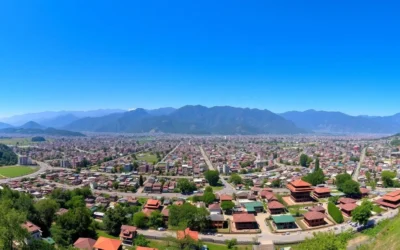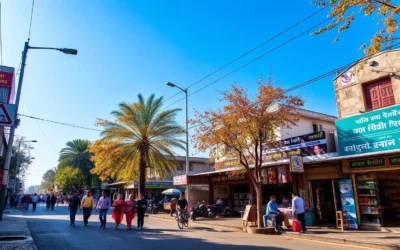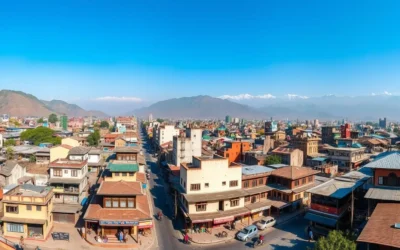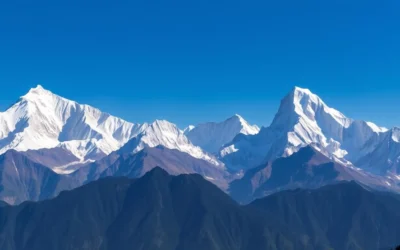✓ Accommodations✓ Flights✓ Rental Cars✓ Tours & Activities
Imagine standing at the foot of the world’s highest peak, surrounded by breathtaking mountains, glaciers, and deep valleys. Mount Everest, towering at 8,848 meters, dominates the landscape of this exceptional area. As you explore this UNESCO World Heritage Site, you’ll discover a sanctuary for diverse flora and fauna, including rare species like the snow leopard and the lesser panda.
The presence of the Sherpas, with their unique culture, adds further interest to this site. As home to some of the most spectacular natural beauty in the world, this national park is a paradise for trekkers, nature enthusiasts, and adventure seekers. You’ll experience the rich cultural heritage and stunning landscapes that make this destination a must-visit.
Discovering Sagarmatha National Park
As you step into Sagarmatha National Park, you are greeted by the majestic beauty of the world’s highest mountains. This park is not just a destination; it’s an experience that encompasses breathtaking landscapes, diverse wildlife, and rich cultural heritage.
Location and Geography
Sagarmatha National Park is located in the Solu-Khumbu District of Nepal’s eastern Himalayas. Established in 1976, it covers an area of roughly 1,148 square kilometers, ranging in elevation from 2,845 meters at Jorsalle to the summit of Mount Everest at 8,848 meters.
The park’s geography is characterized by its vast range of heights and diverse climate zones, supporting a wide variety of flora and fauna. The area includes several famous peaks such as Lhotse, Nuptse, and Cho Oyu, making it a paradise for mountaineers and trekkers.
UNESCO World Heritage Status
In 1979, Sagarmatha National Park was recognized as a UNESCO World Heritage Site due to its exceptional natural beauty and ecological significance. This designation acknowledges the park’s unique biodiversity and the importance of preserving its natural and cultural resources.
The park’s diverse ecosystems, ranging from lower temperate forests to arctic temperatures near the peaks, support a wide range of wildlife. This recognition by UNESCO underscores the need to protect this extraordinary region for future generations.
Key aspects of Sagarmatha National Park include:
– Explore the geographical setting of Sagarmatha National Park, located in the Solu-Khumbu District of Nepal’s eastern Himalayas.
– Understand the vast area covered by the park (1,148 square kilometers) and its impressive elevation range from 2,845 meters at Jorsalle to 8,848 meters at the summit of Mount Everest.
– Learn about the major mountains within the park boundaries, including Mount Everest, Lhotse, Nuptse, and Cho Oyu.
– Discover why UNESCO recognized the park as a World Heritage Site in 1979, acknowledging its exceptional natural beauty and ecological significance.
– Appreciate the park’s varied climate zones, ranging from lower temperate forests to arctic temperatures near the peaks, which support diverse flora and wildlife.
Planning Your Visit to Sagarmatha National Park
Before embarking on your journey to Sagarmatha National Park, it’s crucial to understand the logistics involved. Proper planning ensures a smooth and enjoyable experience in this breathtaking national park.
Best Time to Visit

The best time to visit Sagarmatha National Park is during the spring (March to May) and autumn (September to November). These seasons offer moderate temperatures and clear skies, making them ideal for trekking and taking in the stunning views.
How to Reach the Park

There are two main ways to reach Sagarmatha National Park: by air or by road and trek. The most common route is to fly domestically from Kathmandu to Lukla, a journey that takes about 30-40 minutes. From Lukla, you can begin your trek towards the park, passing through Phakding, Monjo, and Namche Bazaar. Alternatively, you can travel by road from Kathmandu to Jiri or Salleri and then trek to Lukla, offering a more extended adventure.
Entry Fees and Permits
As of the latest updates, the entry fee for Sagarmatha National Park is as follows: Foreign Nationals pay NPR3,000 (approximately USD25) per person, SAARC Nationals pay NPR1,500 (approximately USD12.50) per person, and Nepali Citizens pay NPR100 per person. Understanding these fees and obtaining the necessary permits is essential for a hassle-free visit to the park Nepal.
To make the most of your trip to Sagarmatha National Park, it’s also important to prepare for the temperature variations in the area, which can range from 10°C to 20°C in lower regions during the day to -20°C or lower at higher altitudes, especially in winter. Additionally, planning your itinerary to include acclimatization days is crucial for adjusting to the high altitude and preventing altitude sickness during your experience in the park.
Trek to Everest Base Camp
Embark on a journey of a lifetime as you trek to Everest Base Camp, surrounded by the majestic Himalayas. The trek begins at Lukla airport and follows the Dudh Koshi River up to Namche Bazaar, a quirky marketplace at a high elevation.
The Classic EBC Route
The most well-known route to Everest Base Camp is a days-long trek that passes through places like Syangboche, Tengboche, and Dingboche, offering mesmerizing views of Ama Dablam, Lhotse, and Everest. The base camp trek is not just about reaching the world’s tallest peak but also about experiencing the Himalayan Buddhist culture and getting a closer look at the life of the world-famous mountain climbers, the Sherpas.
Follow the classic Everest Base Camp trek route, starting from Lukla airport and progressing through Phakding, Namche Bazaar, Tengboche, Dingboche, Lobuche, and finally to Everest Base Camp at 5,364 meters. Along the way, you’ll experience a gradual ascent that allows for proper acclimatization while offering increasingly spectacular views of the Himalayan peaks.
What to Expect on the Trek
As you trek to Everest Base Camp, you’ll encounter challenging terrain, basic teahouse accommodations, and changing weather conditions. Be prepared for the physical demands of high-altitude trekking and take in the cultural highlights along the route, including ancient monasteries and opportunities to interact with local Sherpa communities.
The reward of reaching Everest Base Camp is an emotional and physical one, as you’ll stand at the foot of the world’s tallest peak and enjoy panoramic views of the surrounding Himalayan giants.
Explore Namche Bazaar
At an elevation of 3,440 meters, Namche Bazaar is not only a crucial acclimatization point for trekkers but also a hub of cultural and commercial activity. This bustling Sherpa capital is situated in the heart of Sagarmatha National Park and serves as the gateway to Everest.
The Gateway to Everest
Namche Bazaar is a vibrant marketplace where you can find everything from trekking gear and souvenirs to bakeries and internet cafes. It’s a surprising hub of comfort in the mountains, offering a unique blend of traditional Sherpa culture and modern amenities.

Sagarmatha National Park Museum
A visit to the Sagarmatha National Park Museum is a must to learn about the park’s geography, wildlife, and the history of Everest expeditions. The museum provides valuable insights into the natural surroundings and cultural history of the area, enriching your understanding of this world heritage site.
As you explore Namche Bazaar, you can also take a side trip to the Everest View Hotel for spectacular panoramas of Mount Everest and surrounding peaks, or hike to Khumjung village to see the famous “yeti scalp” at its monastery. Your experience in Namche Bazaar will be a memorable part of your adventure in the Everest region, near the majestic peak.
Wildlife Watching in Sagarmatha National Park
As you explore Sagarmatha National Park, you’ll uncover a rich tapestry of wildlife adapted to high-altitude environments. The park is home to a wide range of species, including some that are rare and endangered.
Rare and Endangered Species
Sagarmatha National Park is a habitat for several rare and endangered species. One of the most elusive creatures is the snow leopard, known for its exceptional camouflage abilities in the higher elevations. The red panda is another rare species found in the forested areas between 2,400 and 3,900 meters altitude. You can also spot the Himalayan tahr, musk deer, and the vibrant Himalayan monal, Nepal’s national bird, in their natural habitats.
Best Spots for Wildlife Sightings
The dense forests below Namche Bazaar and the valleys near Thame are excellent locations for wildlife spotting. The quieter trails away from the main Everest Base Camp route also offer opportunities to see a variety of species. Visiting during the early morning or late afternoon can increase your chances of spotting wildlife in Sagarmatha National Park.
By exploring the forests and meadows of Sagarmatha National Park, you can experience the rich biodiversity that makes this national park a unique destination.
Experience Sherpa Culture and Traditions
As you trek through Sagarmatha National Park, you’ll have the unique opportunity to immerse yourself in the rich cultural heritage of the Sherpa people. The park is not just a wonder of nature; it’s also home to the Sherpas, whose customs and way of life are essential to the identity of this region.
Visit Traditional Sherpa Villages
Visiting traditional Sherpa villages like Khumjung, Khunde, and Thame allows you to observe authentic architecture, agricultural practices, and daily life that has remained largely unchanged for generations. You can experience the Sherpa culture firsthand by staying in homestays, visiting local marketplaces, and exploring monasteries.

Cultural Festivals and Celebrations
If your visit coincides with local festivals, you can experience the vibrant culture of the Sherpas. Celebrations like Mani Rimdu (October/November) or Losar (Tibetan New Year in February/March) feature masked dances, religious ceremonies, and community gatherings. Understanding the profound respect Sherpas have for the mountains, particularly Chomolungma (Mount Everest), which they consider sacred, adds depth to your cultural experience.
The Sherpa people’s culture is a significant part of what makes Sagarmatha National Park so unique, making your visit a truly enriching experience.
Visit Ancient Monasteries and Religious Sites
Sagarmatha National Park offers more than just breathtaking mountain vistas; it’s also a journey through the spiritual heart of the Himalayas. As you trek through the region, you’ll have the opportunity to visit some of the most significant monasteries and religious sites in the Everest area.
Tengboche Monastery
Tengboche Monastery, situated at 3,867 meters, is the largest and most famous monastery in the Everest region. It offers spectacular views of Mount Everest, Ama Dablam, and the surrounding peaks. You’ll experience the spiritual atmosphere of this important Buddhist center, where you can observe monks in prayer, attend ceremonies, and receive blessings for a safe journey in the mountains.

Other Significant Religious Sites
In addition to Tengboche, the region is home to other significant monasteries, including Thame Monastery, Khumjung Monastery, and Pangboche Monastery. These religious sites play a vital role in Sherpa culture, serving as both spiritual centers and repositories of art, literature, and traditional knowledge. When visiting these sacred places, it’s essential to respect local customs, such as walking clockwise around religious structures and asking permission before taking photographs of religious ceremonies or monks.
By exploring these ancient monasteries and religious sites, you’ll gain a deeper understanding of the rich cultural heritage of the Sherpa people and experience the unique blend of spirituality and culture that defines this remarkable region.
Alternative Trekking Routes in Sagarmatha National Park
Venture beyond the conventional paths and discover the diverse trekking routes within Sagarmatha National Park. The park offers several alternative treks that are just as breathtaking as the classic Everest Base Camp route.
Gokyo Lakes Trek

The Gokyo Lakes trek is a spectacular alternative, featuring a series of six turquoise glacial lakes and the panoramic viewpoint of Gokyo Ri (5,357m). This trek offers breathtaking views of the surrounding mountains, including Everest, Lhotse, and Makalu.
You will experience the serene beauty of the Gokyo Valley, with its picturesque villages and stunning natural landscapes.
Three Passes Trek

The Three Passes trek is a challenging route that crosses three high passes: Kongma La (5,535m), Cho La (5,420m), and Renjo La (5,340m). This trek offers the most comprehensive circuit of the Everest region for experienced trekkers, with diverse perspectives of the mountain landscapes.
You will be rewarded with unparalleled views of the Himalayas, including Everest, Lhotse, and Makalu, making it a truly unforgettable adventure.
Both the Gokyo Lakes and Three Passes treks offer unique experiences within Sagarmatha National Park, catering to different levels of trekking expertise and interest. Whether you’re looking for serene landscapes or challenging high-altitude passes, these treks have something to offer.
Photography Opportunities in the Park
The park’s unique blend of natural beauty and cultural richness makes it an ideal destination for photography enthusiasts. You can capture the majestic mountains, vibrant culture, and diverse wildlife that Sagarmatha National Park has to offer.
Best Viewpoints for Mountain Panoramas
For breathtaking mountain panoramas, head to Kala Patthar (5,545m) for classic sunrise views of Mount Everest, or Gokyo Ri for panoramic vistas of the world’s highest mountains. The early morning light offers clear skies and dramatic effects on the peaks.
These viewpoints are a photographer’s dream, providing unobstructed views of the Himalayas. Make sure to bring your telephoto lens to capture the intricate details of the mountains.
Capturing Local Life and Nature
Sagarmatha National Park is not just about landscapes; it’s also home to vibrant Sherpa communities and diverse wildlife. Capture authentic cultural moments in Sherpa villages and monasteries, where daily life unfolds against the backdrop of the world’s most impressive mountains.
Be respectful of local customs when photographing people, and keep an eye out for the unique wildlife that inhabits the park.
As you explore the park, you’ll have numerous opportunities to capture the beauty of nature and the richness of the local culture. With its stunning landscapes and diverse subjects, Sagarmatha National Park is a photographer’s paradise.
Conclusion: Why Sagarmatha National Park Should Be on Your Bucket List
Imagine standing at the foot of the world’s highest peak, surrounded by the majestic beauty of Sagarmatha National Park. This UNESCO World Heritage Site is more than just a destination; it’s an experience that combines natural splendor with cultural richness, making it a dream trip for many.
Sagarmatha National Park is home to breathtaking landscapes and diverse wildlife, offering a unique experience for trekkers, nature lovers, and cultural explorers alike. As you plan your visit, you’ll discover why this park is considered a once-in-a-lifetime trip.
The park’s beauty lies not only in its majestic mountains but also in its rich cultural heritage. By visiting Sagarmatha National Park, you’re not only witnessing the grandeur of the peak but also experiencing the resilience of the human spirit in extreme environments.
As you consider making Sagarmatha National Park a part of your dream journey, remember the importance of responsible tourism. By being mindful of your impact, you contribute to preserving this world heritage for future generations, making it a truly meaningful experience to be home in nature.
In conclusion, Sagarmatha National Park is a destination that has something for everyone, making it a must-visit home for adventure seekers and nature lovers worldwide.
The above is subject to change.
Check back often to TRAVEL.COM for the latest travel tips and deals.






